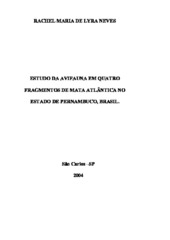Estudo da avifauna em quatro fragmentos de Mata Atlântica no Estado de Pernambuco, Brasil.
Abstract
This research aimed to investigate the avifauna of the Atlantic Rain Forest of Pernambuco State. It took place in four woodland fragments. Two fragments of semideciduos forest at the Ecological Station of Tapacurá (EET), São Lourenço da Mata county: Camocim forest 150ha and Toró forest 100ha. Other two in humid forest: Ecological Refuge Charles Darwin (RECD) with 60ha, in Igarassu county; Gurjaú State Natural Park (RESG), with circa 1077ha, which belongs to three counties of the rainy belt, southward from Recife, Cabo de Santo Agostinho, Jaboatão dos Guararapes and
Moreno. This work is divided into three chapters. The first one is the qualitativequantitative surveys of the avifauna of EET through point count, where the counting of the birds in previously established tracks with five sampling sites distributed in every 200m was made in a 25m radius, lasting 20min. The second is the bionomical and biometrical study of the avifauna pertaining to EET and RECD fragments, where a mist net was used to capture the birds, which were subsequently measured and analyzed for molt, feathers worn and breeding. The third and final chapter consists of the first
evidenced records of Myiarchus tuberculifer for Pernambuco, which was registered during the qualitative-quantitative survey in EET and RESG. The register of this species was made through audio-recording of its vocalizations with Aiwa TP-560 and Sony TCM-5000 mini-audiotapes. The studies carried through in these woodland fragments are highly meaningful for the knowledge and monitoring of the bird populations, as well as to the preservation of the studied areas.
